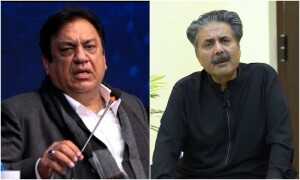
The genesis of miniature painting perhaps lies in Maharashtra’s Ajanta Cave paintings, where manuscripts and smaller paintings were found during the Middle Ages (500 AD to 1500 AD). These ancient painting traditions eventually blended with the Persian miniature to form a style which, after the 17th century, was adopted by most royal courts in the region.
It was at the National College of Arts (NCA) in Lahore, that Haji Muhammad Sharif, once a miniature painter at the court of the Maharaja of Patiala, gave a firm academic foundation to the fading art of miniature painting. His successor was Sheikh Shujaullah, who continued teaching the miniature tradition. At his death, he left behind his devoted student Bashir Ahmad to carry the legacy of this art form forward. Today Prof Bashir Ahmed is well-known for his traditional miniature paintings across the globe with numerous awards to his credit. To showcase his distinguished works, a landmark exhibition of miniature paintings, graphite drawings, acrylic paintings and landscapes was held recently at the Clifton Art Gallery, Karachi.
According to Ahmed, “Miniature painting provides an artistic variety that has evolved over the centuries to become a combination of several cultures and traditions.” With over four decades of extensive painting experience behind him and by pushing the boundaries, Ahmed has discovered countless variations of the miniature painting that was previously the exclusive domain of elite painters at the court of the Mughals.
By pushing the boundaries, Prof Bashir Ahmed has discovered countless variations of miniature painting, which was previously the exclusive domain of elite painters at the court of the Mughals
He has always worked within the traditional boundaries of the genre, which he passed on to his students at the NCA. Today, his students include some of the world’s most celebrated miniaturists such as Shazia Sikander. His miniature paintings are very traditional in nature. These works depict court traditions, portraits of the royals, gardens, hunters, architectural motifs and flora and fauna. Handmade wasli (multi-layered paper), squirrel hair brushes, and natural pigments like grounded pearl, indigo and cinnabar, are some of the tools responsible for these remarkable works. During the 1980s, while experimenting with various textural effects, Ahmed discovered that the glazing quality of quick-drying acrylic paints facilitated the layering process.

Prof Ahmad has served as head of the fine arts department and principal at the NCA, Lahore. In 1983 he constituted the first ever bachelor’s degree curriculum for miniature painting, which to date, continues to produce numerous successful artists. Presently he is conducting regular courses in traditional painting at the Mushtaq Ahmed Gurmani Trust in Lahore.
‘The Legacy Continues’ was shown at the Clifton Art Gallery in Karachi from September 22nd till October 2nd, 2016
Published in Dawn, Sunday Magazine, October 16th, 2016















































Dear visitor, the comments section is undergoing an overhaul and will return soon.